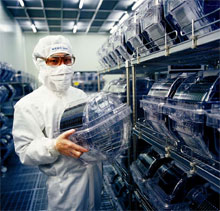Lack of U.S. solar investment urges Natcore’s second foreign joint venture
 As politicians rail against the failure of a government investment in now-defunct solar manufacturer Solyndra, a different U.S. solar company with promising technology has turned to foreign investors.
As politicians rail against the failure of a government investment in now-defunct solar manufacturer Solyndra, a different U.S. solar company with promising technology has turned to foreign investors.
Natcore Technology, headquartered in New Jersey, was already involved in a joint venture to produce its liquid phase deposition (LPD) solar cells in China. But it announced this week that it has signed another joint venture research and development agreement with MX Solar, Italy’s largest solar panel manufacturer.
“We were hoping to do business in the U.S.,” said Natcore CEO Chuck Provini. “But that’s looking to be impossible.”
Provini signed a deal in China in June of 2010 to develop its solar technology there. When ABC News got wind of it, Provini said they tracked him down for an on-air interview late the night before he signed the deal.
In the interview, Provini explained that he was politely rejected when he asked for fundraising assistance in Washington, D.C., before China eagerly flew him over.
“The next day, I got a call from the White House,” Provini said. “It’s really comical, right? I was like, ‘no, who is this, really?’”
It really was the White House. Staff invited him over and asked what the government needed to do in order to keep promising technologies like the one Natcore is developing from leaving the US market.
Provini said he didn’t expect direct funding, but hoped the government would help connect Natcore with a larger corporation that had received government funding and would be willing to go in for a joint venture deal like the one he signed with a Chinese corporation.
It seemed like something might work out, but it never did.
After years of doing research at Ohio State University and Rice University, Natcore decided it was time for its own lab and raised a few million dollars, Provini said.
The company sent letters to several states asking them to explain why Natcore should put its lab there.
Provini only heard back from the representative from Rochester, New York, and from New Jersey.
The representative from New York asked what Natcore needed, and Provini said the company needed introductions to bigger players with more money. The representative hosted a gathering with 30 major solar companies and MX Solar became extremely interested in doing business with Natcore, Provini said.
That’s how it all got rolling.
Now a consortium of five Italian solar panel manufacturers plan to open a solar cell manufacturing facility so they can control their own solar cell supply.
“Right now they’re buying from Asia,” Provini said.
All of the European companies, including the big players in Germany, are using the same types of solar cells, Provini said.
“The Italian manufacturers also want product differentiation,” he said.
Natcore’s liquid technology allows the companies an opportunity to create a more efficient solar cell using less polysilicon, thus at a cheaper price.
While Provini is two for zero on big business partnership with U.S. companies, the former U.S. Marine is still hopeful he’ll get to do good work in this country and create jobs here.
He said he expects MX Solar will be interested in employing Natcore’s technology at its facility in New Jersey. He also said he expects to expand into the chemical business, providing supplies for “the magic sauce” used to create solar cells with Natcore’s technology.
Image courtesy of Natcore.



